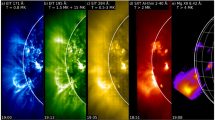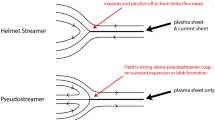Abstract
Radio bursts in the frequency range of 100–1500 kHz, recorded in 1997–2000 on the INTERBALL-1 satellite during the solar flares preceding the strong geomagnetic storms with D st < −100 nT, are analyzed in this paper. The observed long-wave III-type radio bursts of solar origin at frequencies of 1460 and 780 kHz were characterized by large values of the flux S f = 10−15 −10−17 W/m2 Hz and duration longer than 10 min. The rapid frequency drift of a modulated radio burst continued up to a frequency of 250 kHz, which testified that the exciting agent (a beam of energetic electrons) propagated from the Sun to the Earth. All such flares were characterized by the appearance of halo coronal mass ejections, observed by the LASCO/SOHO, and by the presence of a southward Bz-component of the IMF, measured on the ACE and WIND spacecraft. In addition, shortly after radio bursts, the INTERBALL-1 satellite has recorded the fluxes of energetic electrons with E > 40 keV.
Similar content being viewed by others
References
Cole, D.G., Space Weather: Its Effects and Predictability, Space Science Reviews, 2003, vol. 107, nos. 1–2, pp. 295–302.
Bothmer, V., The Solar Atmosphere and Space Weather, in Solar System Update, Blondel, B. and Mason, J., Eds. Berlin: Springer, 2006.
Solar and Heliospheric Origins of Space Weather Phenomena, J.-P. Rozelot, J.-P., Ed., New York: Published by LLC, 2006.
Gonzalez, W.D., Tsurutani, B.T., Lepping, R.P., and Schwenn, R., Interplanetary Phenomena Associated with Very Intense Geomagnetic Storms, J. Atm. Sol.-Terr. Phys., 2002, vol. 64, no. 2, pp. 173–183.
Crooker, N.U., Solar and Heliospheric Geoeffective Disturbances, J. Atm. Sol.- Terr. Phys., 2000, vol. 62, no. 12, p. 1071.
Zhang, J., Liemohn, M.W., Kozyra, J.U., Lynch, B.J., and Zurbucher, T.H., A Statistical Study of the Geoeffectiveness of Magnetic Clouds during High Solar Activity Years, J. Geophys. Res., 2004, vol. 109, A09101. doi:10.1029/2004JA010410.
Zhao, X.P. and Webb, D.F., The Source Regions and Storm-Effectiveness of Front Side Full Halo Coronal Mass Ejection, J. Geophys. Res., 2003, vol. 108, no. A6, p. 1234.
Huttunen, K.E.J., Koskinen, H.E.J., and Schwenn, R., Variability of Magnetospheric Storms Driven by Different Solar Wind Perturbations, J. Geophys. Res., 2002, vol. 107, no. A7, p. 1121. doi:1029/2001JA00171.
Yermolaev, Yu.I. and Yermolaev, M.Yu., Statistical Relationships between Solar, Interplanetary, and Geomagnetospheric Disturbances, 1976–2000, Kosm. Issled. (Cosmic Res.), 2002, vol. 40, no. 1, pp. 3–16.
Richardson, I.G., Cane, H.V., and Cliver, E.W., Sources of Geomagnetic Activity during Nearly Three Solar Cycles (1972–2000), J. Geophys. Res., 2002, vol. 107, no. A8, p. 1187. doi:10.1029/2001JA000504.
Viera, L.E.A., Gonzalez, W.D., Echer, E., and Tsurutani, B.T., Storm-Intensity Criteria for Several Classes of the Driving Interplanetary Structures, Solar Phys., 2004, vol. 223, nos. 1-2, pp. 245–258. doi:10.1007/s11207004-1163-2.
Echer, E. and Gonzalez, W.D., Geoeffectiveness of Interplanetary Shocks, Magnetic Clouds, Sector Boundary Crossings and Their Combined Occurrence, Geophys. Res. Lett., 2004, vol. 31, no. 9, p. L09808. doi:10.1029/2003GL019199.
Huttunen, K.E.J. and Koskinen, H.E.J., Importance of Post-Shock Streams and Sheath Region as Drivers of Intense Magnetospheric Storms and High-Latitude Activity, Ann. Geophys., 2004, vol. 22, p. 1729.
Yermolaev, Yu.I., Yermolaev, M.Yu., Zastenker, G.N., et al., Statistical Studies of Geomagnetic Storm Dependencies on Solar and Interplanetary Events: A Review, Planet. Space Sci., 2005, vol. 53, nos. 1–3, pp. 189–196.
Yermolaev, Yu.I., Yermolaev, M.Yu., Lodkina, I.G., and Nikolaeva, N.S., Statistical Investigation of Heliospheric Conditions Resulting in Magnetic Storms, Kosm. Issled. (Cosmic Res.), 2007, vol. 45, no. 1, pp. 3–11.
Yashiro, S., Gopalswamy, N., Akiyama, S., et al., Visibility of Coronal Mass Ejection as Function of Flare Location and Intensity, J. Geophys. Res., 2005, vol. 110, no. A12. doi:10.1029/2005JA011151.
Wang, Y.M., Ye, P.Z., Wang, S., Zhou, G.P., and Wang, J.X., A Statistical Study on the Geoeffectiveness of Earth-Directed Coronal Mass Ejection from March 1997 to December 2000, J. Geophys. Res., 2002, vol. 107, p. A11. doi:10.1029/2002JA009244.
Srivastava, N. and Venkatakrishnan, P., Solar and Interplanetary Sources of Major Geomagnetic Storms during 1996–2002, J. Geophys. Res., 2004, vol. 109, A10103. doi:10.1029/2003JA010175.
Gopalswamy, N., Yashiro, S., Kaiser, M.L., Howard, R.A., and Bougeret, J.-L., Characteristics of CME, Associated with Long Wavelength Type II Radio Bursts, J. Geophys. Res., 2001, vol. 106, no. A12, p. 29219.
Zhang, J., Dere, K.P., and Bothmer, V., Identification of Solar Sources of Major Geomagnetic Storms between 1996 and 2000, Astrophys. J., 2003, vol. 582, pp. 520–533. doi:10.1029/2002JA010175
Cane, H., Richardson, J.G., and St.Cyr, O.C., Coronal Mass Ejections, Interplanetary Ejecta and Geomagnetic Storms, Geophys. Res. Lett., 2000, vol. 27, p. 3591.
Fry, C.D., Dryer, M., Smith, Z., Sun, W., Deehr, C.S., and Akasofu, S.-I., Forecasting of Solar Wind Structures and Shock Arrival Times Using an Ensemble of Models, J. Geophys. Res., 2003, vol. 108, no. A2, p. 1070.
Yermolaev, Yu.I. and Yermolaev, M.Yu., Statistical Relationships between Solar, Interplanetary, and Geomagnetospheric Disturbances, 1976–2000: 2, Kosm. Issled. (Cosmic Res.), 2003, vol. 41, no. 2, pp. 115–119.
Smith, Z. and Murtagh, W., Relationship between Solar Wind Low Energy Energetic Ion Enhancement and Large Geomagnetic Storms, J. Geophys. Res., 2004, vol. 109, no. A1, p. AO1110. doi:10.1029/2003JA010044.
Leblanc, Y., Dulk, G.A., Bougeret, J.-L., Tracing the Electron Density from Corona to 1 AU, Solar Phys., 1998, vol. 183, pp. 165–180.
Gopalswamy, N., Interplanetary Radio Bursts, in The Sun and the Heliosphere as Integrated System, ASSL Series, Poletto, G. and Suess, S., Eds. Boston: Kluwer, 2004, Chap. 8, p. 201.
Pick, M., Forbes, T.G., Mann, G., Cane, H.V., and Chen, J., Multi-Wavelength Observations of CMEs and Associated Phenomena, Space Science Reviews, 2006, vol. 12, pp. 341–382.
Prokudina, V.S. and Kuril’chik, V.N., A Study of Long-Wave Radio Bursts Observed in 2000 onboard the INTERBALL-1 Satellite, Kosm. Issled. (Cosmic Res.), 2003, vol. 41, no. 4, pp. 428–437.
Kuril’chik, V.N., Prokudina, V.S., Kudela, K., and Slivka, M., Hectometer Radio Bursts and Energetic Electrons during Solar Flares According to Observations onboard the INTERBALL-1 Satellite, Kosm. Issled. (Cosmic Res.), 2006, vol. 44, no. 3, pp. 199–208.
Roelof, E.C., Haggerty, D.K., and Simnett, G.M., Three Distinct Populations of Solar Energetic Electrons: Flare, Beam and Type III, Bull. Amer. Astron. Soc., 2003, vol. 35, no. 35.
Cane, H.V. and Lario, D., An Introduction To CMEs and Energetic Particles, Space Science Rev., 2006, vol. 123, pp. 45–56.
Ivanov, K., A Series of Extreme Solar-Terrestrial Storms in May–October 2000, Geomagn. Aeron., 2004, vol. 44, no. 2, pp. 147–154.
Siscoe, G. and Schwenn, R., CME Disturbance Forcasting, Space Science Rev., 2006, vol. 123, pp. 453–470.
Author information
Authors and Affiliations
Additional information
Original Russian Text © V.S. Prokudina, V.N. Kuril’chik, Yu.I. Yermolaev, K. Kudela, M. Slivka, 2009, published in Kosmicheskie Issledovaniya, 2009, Vol. 47, No. 1, pp. 17–24.
Rights and permissions
About this article
Cite this article
Prokudina, V.S., Kuril’chik, V.N., Yermolaev, Y.I. et al. Peculiarities of long-wave radio bursts from solar flares preceding strong geomagnetic storms. Cosmic Res 47, 14–21 (2009). https://doi.org/10.1134/S001095250901002X
Received:
Published:
Issue Date:
DOI: https://doi.org/10.1134/S001095250901002X




